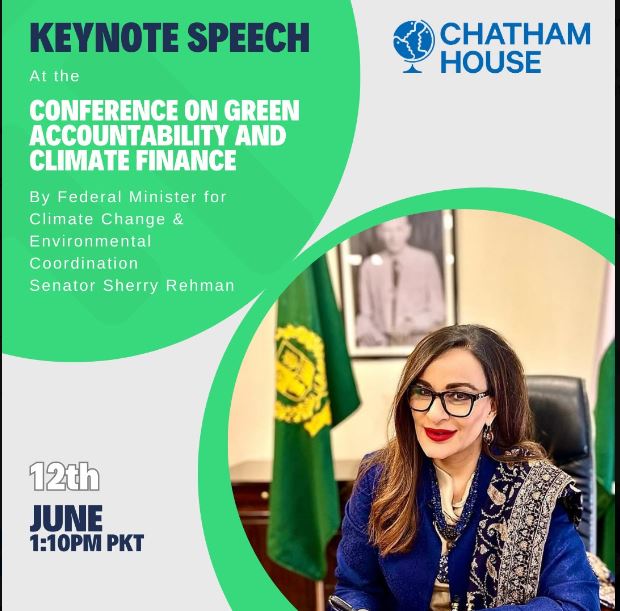Green Financing Mechanisms are Difficult to Access: Pakistan’s Minister for Climate Change
Pakistan alone needs to invest $348 billion by 2030 as per the World Bank’s CCDR
Islamabad: “A fair amount of thought leadership and retooling is needed, both for markets and public institutions to change their instruments to meet quantum growing needs, as navigating a forest of barriers has become normalised for accessing a small percentage green financing,” said Pakistan’s Federal Minister for Climate Change and Environmental Coordination, Senator Sherry Rehman, on Monday.
The minister made these remarks while keynoting virtually at a Chatham House Conference on Green Accountability and Climate Finance.

Senator said, “The accelerated impacts of climate change require transformational thinking, both in terms of the quantum needed for social impact, but also to bridge the dangerous gap between different levels of emitters, especially for the less-prepared developing world, where the speed and scale of financing can mean the difference now between survival and subsistence, development or dystopia.
“The scale of human suffering has totally changed because climate change is coming at us so fast and furious that we’re having trouble just understanding its scale and velocity. It can’t even be called ‘climate change’ anymore, it’s a ‘climate emergency’,” she added.
She said that the UN estimates that developing countries already need $70 billion per year to cover adaptation costs now and will need $140 to $300 billion in 2030, rising to $280-500 billion by 2050, but she reiterated that these numbers are also underestimated.
She highlighted that Pakistan alone needs to invest $348 billion by 2030 as per the World Bank’s CCDR Report to keep its head above water.
“As it stands, the capitalisation of public financing funds is at a fraction of global pledges made. The total annual investment requirement of developing countries would hit $2.4 trillion by 2030 but no such amount or fund or resource is available to climate-distressed countries trying to access climate funds to actually rebuild resilience in real-time.”
The formal green financing mechanisms themselves, such as the GCF and GEF, while important, are difficult to access because they require projectisation which then goes into onerous competitive bidding processes, taking more than a year to materialize, she said.
“Additionally, the problem of double counting is a serious issue, causing a lack of trust in lending from both bilateral and MDBs to developing countries, as it can simultaneously count towards meeting climate change obligations and development commitments,” she said.
The minister said that other than pitching for carbon credits on market frameworks that are non-standardised and fragmented, green financing has become a site of growing contests, so the private sector and businesses must be brought to the table for scaling up the surge of climate financing that is needed. She said, “Big business remains outside of the formal negotiations naturally at multilateral convenings but needs to be brought in as part of the solution.
“We can’t anymore expect just rich states to be the only source of formal funds, and in the current frameworks, the private sector, or blended finance has not been able to tip the scales for countries in distress, because investors look for profits. Countries struggling with both debt and climate challenges cannot attract the level of climate financing or private investment needed at non-predatory or concessional terms.
“The public sector financing is clearly drying up, and what is needed right now is for big business to be part of the solution which I am sure they’ll want to be, instead of running dazzling side shows at the COP convenings.”
Responding to the conference agenda of enhancing transparency and accountability of green financial mechanisms, the minister highlighted the challenges of accountability in climate finance, noting that while there have been some successes in controlling corruption in overseas development assistance for the public sector, Transparency International reports that significant amounts of climate finance bypass typical control channels.
The complexity of the institutional network governing climate finance at international, national, and local levels contributes to this issue.
The minister emphasised the importance of multi-stakeholder accountability mechanisms to enhance transparency in designing, implementing, and monitoring adaptation and mitigation frameworks.
She concluded, “The global climate crisis has left no country untouched, but it is the developing world that is facing the most severe consequences.”
In this context, while IFIs have been crucial players in providing technical support and loan-based support, they must re-adapt their instruments and broaden their initiatives and share expertise to allow more grant-based financing.
The resources needed to limit the reversal of development gains that extreme weather brings, to mitigate risks associated with climate shocks and global crises and prevent the weakening of the resilience of populations to climate change, are estimated at $4.2 trillion. Leaders in the Global South are calling for the restructuring of global financial institutions to enable climate financing since they were designed for a post-WWII world order and not for the post-climate change era of today.
The functioning of these institutions needs to change to handle the most extensive mobilisation of international finance in history to help developing nations adapt to and cope with a warming planet. If enhanced transparency and audits can incentivize change and trigger investments on the ground, we could all benefit from this exercise in real time, said the minister.







